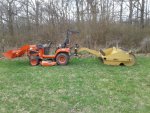Or just call Bill Murray. This is so reminiscent of Caddy Shack. If I read the word gopher, I instantly think of that movie.
On the serious side, though:
If you've got grass/trees in the area, you're gonna be getting a lot of surface debris/roots that mix with the dirt, and basically stop the blade from cutting. While mixing the debris into the soil is normally a good thing in gardening, not so much with a box blade when trying to level. The debris tends to catch the dirt and make worse mounds than the gophers. The blade was designed to cut dirt, but ain't worth diddly on straw and fine roots. Don't get me wrong, I like my BB, but it didn't take long to figure out I was using a left-handed waffle turner in a right handed iron. I found the scarifiers help collect some of it like a coarse rake, but they don't sift the dirt out so well because they don't roll the debris. So, do you push the debris into a hole somewhere, or find a way to use it? I'm filling up erosion ditches with it, trying to reclaim a lot that should have been cleaned and prepped back in 1975 when my house was built. I'll worry about the drainage when I get that far in the yard.
What one other suggested about pushing with the BB is actually a brilliant idea for knocking down the mounds before you try to smooth them. Pushing (backward) with the BB makes it a bit more aggressive on a mound of dirt because the 3PH won't lift when the blade digs in. It behaves more like a dozer than a scraper when going backward. Tilting it to neutral (no forward or reverse tilt) will keep it from trying to dig too deep, but still let it scalp high spots. I had several mounds from uprooted trees that storms pushed over. I pushed the mounds into the associated holes, then put the scarifiers down to loosen up the soil some, and finally, just scraped and packed until I was happy with the surface. Don't know how much this compares to your gopher problem, but a mound is a mound and a hole is a hole.
Having done a similar job on a Ford 3000 with a 10' disc and 20 feet of train rail in a large open field that wild hogs had rooted in, you're in for the ride of your life if you choose this option. We were planting millet for dove hunting fields. You might guess why the wild hogs were so excited after the millet was ripe. If you cultivate with the disc, then drag the rail behind it, you will have a very level and smooth lot. I don't remember the field size, but I spent 14 hours on that tractor that day, being bounced off the fenders and shaken like a rag doll, with no seat belts or safety switches, mind you. But I was 15, strong, and really scared of coming off that big tractor. I think I pinched a hole in the steel seat a couple times. There were wallows that 3000 would disappear in. I can't imagine a tiller being any better, because the implement isn't what's going to beat you up. It's the hills/holes that are bigger than the tractor, let alone the wheels/tires.
Discs don't like real slow speed, but you don't want them throwing dirt in the air, either. Just fast enough to roll it over, which probably won't be a very comfortable speed in what you describe. Don't try to sink the disc to the spindles on the first pass either. Good way to break a disc in hard soil or root hazards. Don't ask me how I know or how many I've had to change, and it always seemed to be one that required complete disassembly of the shaft. There was typically a lecture involved as well. Discs won't typically turn the soil as well at creep speed which you will want to run on very rough terrain. Just gonna have to wear the belt and hang on. Turning and moving the dirt is part of the levelling process. Multiple passes will completely pulverize ANYTHING in the soil. You decide what's pulverized enough. Same principle with the rail, multiple passes to drag down all the high spots and fill up the holes as needed. It will tend to pack some as it smooths. This was also an annual treatment for our small feed corn field, to chop up the stalks and smooth out the previous year's rows. You might want to make one more shallow pass with the disc and a piece of chain-link fence for a drag after that to remedy deeper tire tracks and packed spots.
Another option, that I'm considering because I also have some terrain smoothing objectives, is a landscaping rake. They're not super expensive, and can probably find other purposes as well as levelling soil and debris collection/removal. I have plenty rocks (golf ball to basketball size) and roots to test the quality and durability of any rake that claims to be the best. I'm also considering a scarifier without a blade, that I can follow up with the rake. Something like a mulit-tooth sub soiler, but not as large. Dunno if I can find such a beast, but I can see a much quicker surface prep method with that. Gotta break up the soil before it can be moved.



